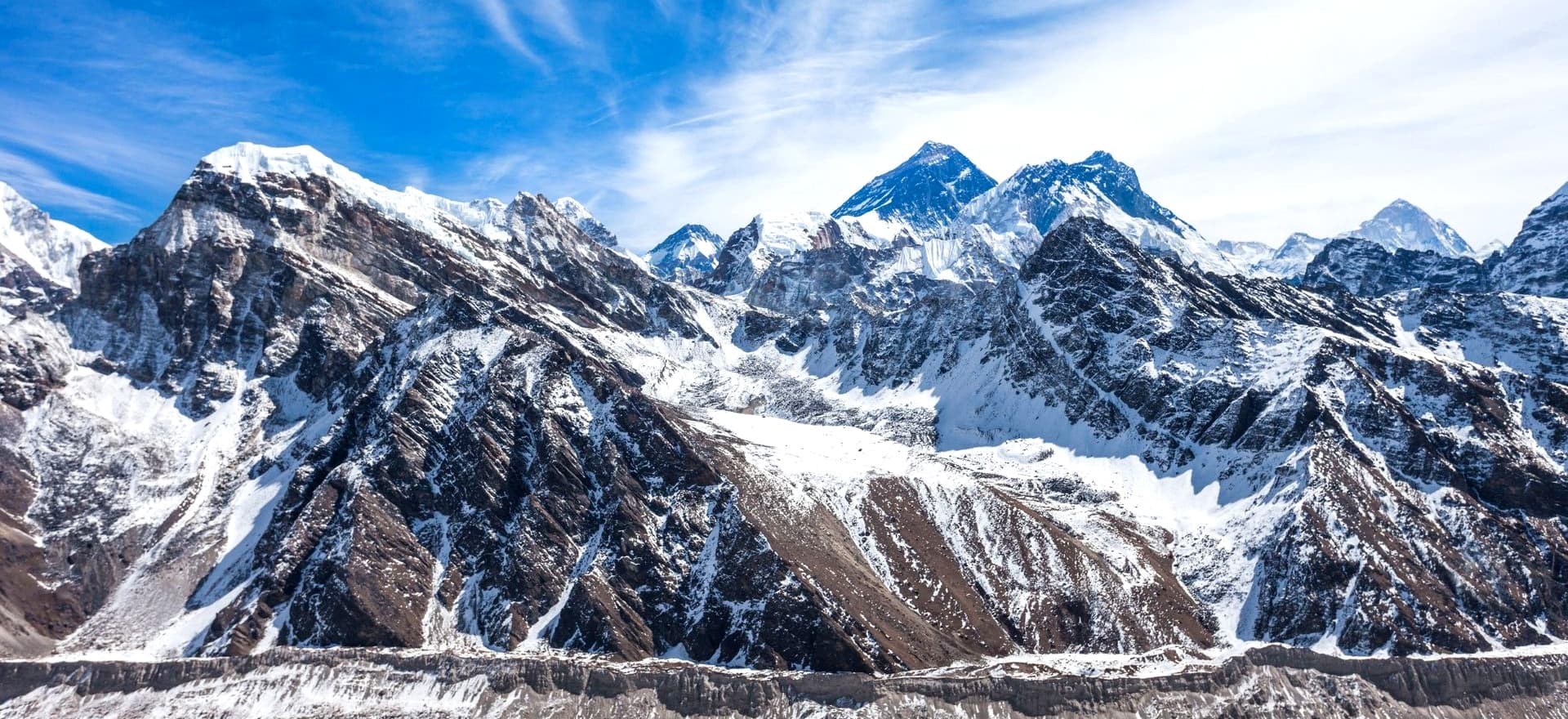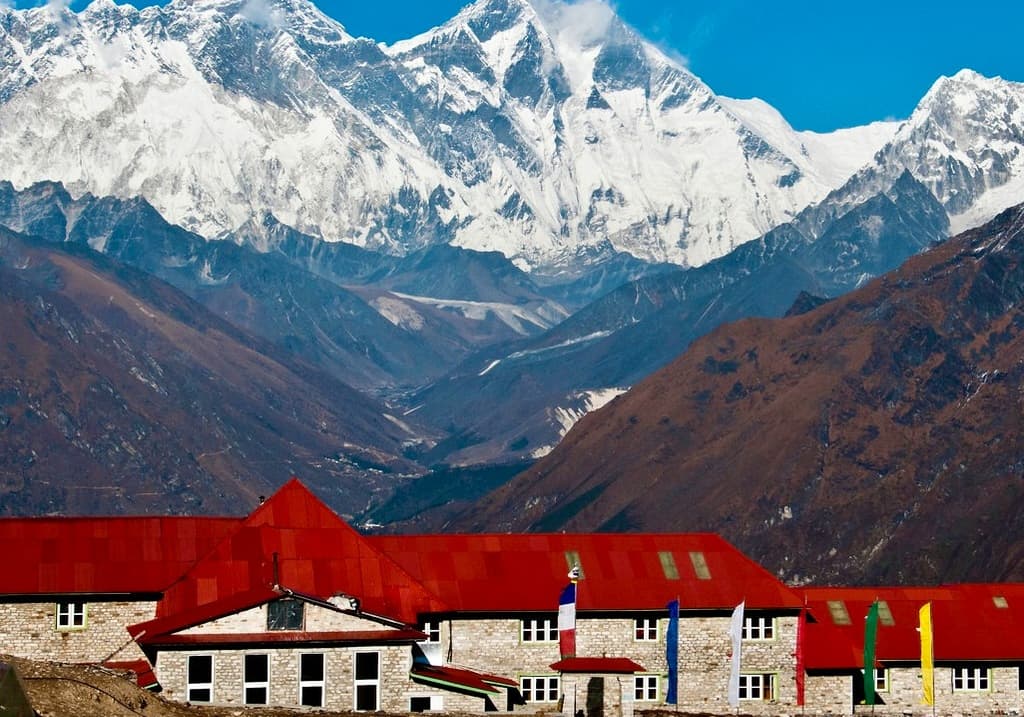Pick the best acclimatization itinerary for your Everest Base Camp Trek
Everest Base Camp (EBC) is the starting point for mountaineers attempting to conquer Mount Everest, situated in Nepal's Khumbu region at an altitude of approximately 5,364 meters (17,598 feet). It serves as a temporary campsite during the climbing season, where climbers and support teams prepare for the challenging ascent. Though not the actual summit, EBC attracts trekkers from around the world seeking breathtaking views of the surrounding peaks and the awe-inspiring Khumbu Icefall.
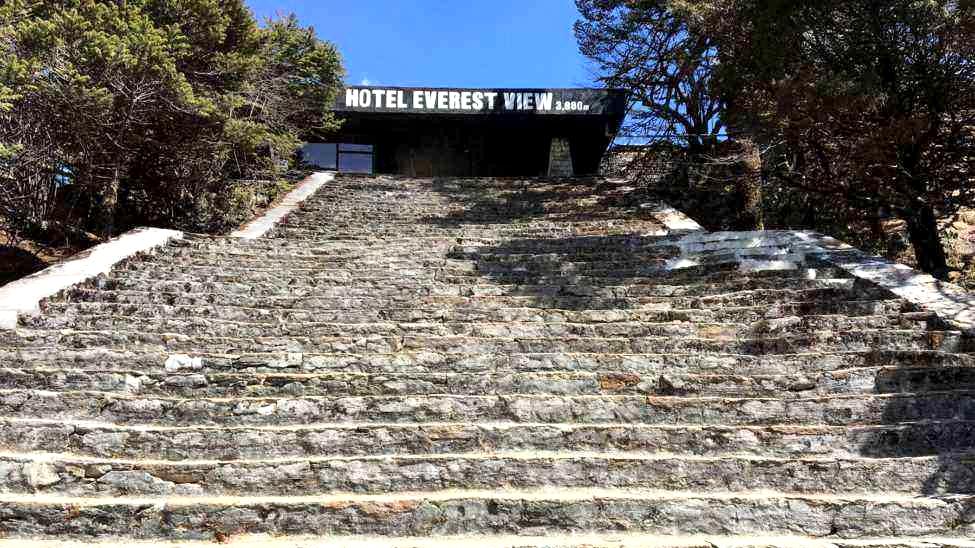
The Everest Base Camp Trek is an iconic and sought-after trekking adventure that takes adventurers to the foot of Mount Everest. Beginning with a scenic flight from Kathmandu to Lukla, the trek proceeds through picturesque Sherpa villages, lush valleys, and ancient monasteries. Namche Bazaar, Tengboche Monastery, and Kala Patthar are some of the key highlights offering stunning views of Everest and the neighboring peaks. The trek incorporates essential acclimatization days to adapt to the high altitude, ensuring a safer and more enjoyable experience. Accommodation is available in tea houses along the trail, providing basic but comfortable lodging and nourishing meals. The trek is best undertaken during the spring and autumn seasons when weather conditions are favorable, making the journey physically demanding yet rewarding, offering an unparalleled chance to immerse in the Himalayan culture and be captivated by the majestic beauty of Mount Everest.
Understanding Acclimatization
Acclimatization is a vital process that your body undergoes when you ascend to high altitudes. With every step upwards, the air becomes less dense, meaning there are fewer oxygen molecules per breath. If your body doesn't get enough time to adjust to this reduced oxygen level, it can lead to a potentially life-threatening condition known as Acute Mountain Sickness (AMS).
Acclimatization is essentially your body's way of adapting to the decrease in oxygen molecules available at a high altitude. Some of the adjustments your body makes during acclimatization include:
- Breathing Rate: As the air's oxygen content decreases with altitude, your body responds by breathing faster to increase oxygen intake.
- Hemoglobin Levels: Your body may produce more hemoglobin—the protein in your blood that carries oxygen—to improve the efficiency of oxygen transport from your lungs to other tissues.
- Increased Diuresis: High altitudes may cause increased urination, which helps the body maintain appropriate pH levels in the blood.
- Metabolic Efficiency: Your body can improve its ability to utilize oxygen more efficiently, reducing the impact of reduced oxygen availability.
It's important to note that acclimatization is a slow process. Everyone's body responds differently, and there's no way to speed up your body's natural acclimatization process. That's why it's crucial to ascend gradually, giving your body enough time to adapt to the new altitude before climbing higher. This is a concept often referred to as "climb high, sleep low", which is crucial in maintaining health and avoiding AMS during high-altitude treks like the Everest Base Camp Trek.
Acclimatization in the Everest Region
Acclimatization is especially important in the Everest region due to the significantly high altitudes. The Everest Base Camp sits at an altitude of about 5,364 meters (17,598 feet). Trekking to such a high altitude without properly acclimatizing can lead to serious health problems, including Acute Mountain Sickness (AMS), High-Altitude Pulmonary Edema (HAPE), and High-Altitude Cerebral Edema (HACE).
To ensure you acclimatize properly during your Everest Base Camp Trek, your itinerary should include acclimatization days. These are days where you stay at the same altitude or do an acclimatization hike to higher altitudes then descend back to sleep, aiding the acclimatization process.
Namche Bazaar, at an altitude of approximately 3,440 meters (11,286 feet), and Dingboche, at about 4,410 meters (14,469 feet), are two common places where trekkers spend extra nights for acclimatization. These villages are strategically placed along the trail and offer suitable environments for your body to adjust.
Acclimatization hikes are also commonly undertaken in these villages. In Namche Bazaar, you can hike to the Everest View Hotel or Khumjung Village, while in Dingboche, an acclimatization hike to Nangkartshang Peak is common.
Acclimatizing well is not only essential for your health and safety, but it also increases your chances of successfully reaching the Everest Base Camp. It helps you maintain your strength and stamina, and enjoy the trek instead of just struggling through it. Always remember, when trekking in the Himalayas, it's not about speed; it's about sustainability.
Highlights of the Everest Base Camp Trek
The Everest Base Camp (EBC) Trek is a remarkable journey through the breathtaking landscapes of the Himalayas, offering trekkers a chance to witness some of the world's highest peaks and immerse themselves in the Sherpa culture. Here are the key highlights of the Everest Base Camp Trek:
- Scenic Mountain Flight: The Everest Base Camp Trek begins with a short and thrilling flight from Kathmandu to Lukla. The flight offers mesmerizing views of the Himalayan peaks, including Everest, Lhotse, and Nuptse. Landing at Lukla's Tenzing-Hillary Airport, which sits on a small airstrip carved into the mountainside, is an adventure in itself and adds excitement to the start of the trek.
- Namche Bazaar: Namche Bazaar is a vibrant and bustling Sherpa town and a crucial acclimatization stop during the trek. The town is famous for its lively Saturday market, where trekkers can find a variety of goods, from trekking gear to local handicrafts. It also offers stunning views of Everest and neighboring peaks, making it an excellent place to rest and acclimate before proceeding further.
- Tengboche Monastery: The Tengboche Monastery is one of the most significant religious sites in the region. Surrounded by awe-inspiring mountain vistas, the monastery offers trekkers a chance to witness traditional Buddhist ceremonies and soak in the peaceful ambiance. The panoramic view of Everest and Ama Dablam from the monastery's courtyard is a sight to behold.
- Everest Viewpoints: Kala Patthar, meaning "Black Rock" in Nepali, is a famous viewpoint situated at 5,545 meters (18,192 feet) above sea level. It provides one of the best panoramic views of Mount Everest, as well as neighboring peaks, at sunrise. Everest Base Camp itself is a thrilling destination, offering trekkers the unique opportunity to stand at the base of the world's highest mountain and witness the hustle and bustle of Everest expeditions during the climbing season.
- Khumbu Glacier and Icefall: The trek takes trekkers through the awe-inspiring Khumbu Glacier, a massive ice river formed by the accumulation of snow over centuries. As the route proceeds towards Everest Base Camp, trekkers can catch glimpses of the treacherous Khumbu Icefall, a section of the climbing route for Everest expeditions. It is a constantly changing ice structure that poses significant challenges to mountaineers.
- Sherpa Culture: The Everest region is predominantly inhabited by the Sherpa community, renowned for its mountaineering prowess and warm hospitality. Trekking through Sherpa villages like Namche, Pangboche, and Dingboche allows trekkers to experience the unique Sherpa culture, traditions, and lifestyle. Interacting with the locals and learning about their customs adds a cultural dimension to the trek.
- Sagarmatha National Park: The Sagarmatha National Park, a UNESCO World Heritage site, is home to diverse flora and fauna. Trekkers can encounter various species of plants, including colorful rhododendrons, as well as wildlife like the Himalayan tahr, musk deer, and even elusive snow leopards if lucky. The park's conservation efforts make it a vital area for preserving the unique biodiversity of the Himalayas.
- Pristine Landscapes: The Everest Base Camp Trek offers a diverse range of landscapes, starting with lush rhododendron and pine forests in the lower regions and gradually transforming into barren, high-altitude terrains as trekkers approach the Everest region. The contrasting scenery, including river valleys, glacial moraines, and rocky ridges, provides an ever-changing and awe-inspiring journey.
- Acclimatization: Acclimatization is critical during the Everest Base Camp Trek to help trekkers adapt to the high altitude and reduce the risk of altitude sickness. Acclimatization days are strategically incorporated into the trek, allowing trekkers to rest, explore nearby areas, and gradually ascend to higher altitudes. These essential rest days play a crucial role in ensuring a safe and enjoyable experience.
- Personal Achievement: Reaching Everest Base Camp is a significant personal accomplishment for trekkers, regardless of their mountaineering aspirations. Standing at the foot of the world's highest mountain and witnessing the awe-inspiring Himalayan landscape creates a sense of triumph and fulfillment that stays with trekkers long after they return home. The sense of achievement and the memories made during the trek become cherished experiences for a lifetime.
The Everest Base Camp Trek is a journey of a lifetime, providing a unique opportunity to connect with the grandeur of the Himalayas, experience the rich Sherpa culture, and challenge oneself amidst the world's highest peaks.
Best acclimatization itinerary for your Everest Base Camp Trek
Here's a recommended acclimatization itinerary for the Everest Base Camp Trek to help reduce the risk of altitude sickness and ensure a safe and enjoyable journey:
 Trek-3.jpg)
Everest Base Camp Trek Itinerary
Day 01: Arrival at Tribhuvan International Airport, Kathmandu, and Pre-trip meeting.
Upon your arrival at Tribhuvan International Airport in Kathmandu, you will be warmly welcomed by our representative and transferred to your hotel. In the evening, there will be a pre-trip meeting where your trekking guide will provide essential information about the Everest Base Camp Trek, go over the itinerary, and answer any questions you may have.
Day 02: A guided sightseeing tour of Kathmandu Valley
Today, you will explore the cultural and historical wonders of Kathmandu Valley. Your experienced guide will take you to visit the UNESCO World Heritage Sites, including Boudhanath Stupa - one of the largest stupas in the world, Pashupatinath Temple - a sacred Hindu pilgrimage site, Swayambhunath Stupa (also known as the Monkey Temple), and Kathmandu Durbar Square - the historical heart of the city with ancient palaces, temples, and courtyards.
Day 03: Fly to Lukla (2,800 m) from Kathmandu, trek to Phakding (2,651 m): 35 min flight / 3 - 4 hours trek
An early morning scenic flight takes you to Lukla, a gateway to the Everest region. After landing, meet the rest of the trekking crew and start your trek toward Phakding. The trail leads you through lush forests, crossing suspension bridges over the Dudh Koshi River, and passing by small villages, where you can experience the local Sherpa culture.
Day 04: Trek from Phakding to Namche Bazaar: 5 - 7 hours trek
Today's trek takes you along the Dudh Koshi River and through dense rhododendrons and pine forests. After a challenging uphill climb, you will arrive at Namche Bazaar, the bustling Sherpa town and the commercial hub of the Everest region. Namche offers stunning views of Everest, Lhotse, and other surrounding peaks.
Day 05: Acclimatization Day - Namche Bazaar
Acclimatization is essential for adjusting to the increasing altitude. Spend the day exploring Namche Bazaar and its surroundings. You can hike to Everest View Hotel, the highest hotel in the world, to enjoy breathtaking views of Everest, Lhotse, Ama Dablam, and other peaks. You can also visit the Sherpa Culture Museum and the Everest Photo Gallery to learn more about the local culture and mountaineering history.
Day 06: Trek from Namche Bazaar to Tengboche: 5 - 6 hours trek
The trail from Namche to Tengboche offers panoramic views of the Everest region. After a steady descent, you'll cross the Dudh Koshi River and then ascend through rhododendron forests to reach Tengboche. Here, you'll visit the famous Tengboche Monastery, the spiritual center of the region, and enjoy stunning views of Everest, Ama Dablam, and other peaks.
Day 07: Trek from Tengboche to Dingboche: 5 - 6 hours trek
The trail leads you through beautiful landscapes, passing several chortens and Mani walls. As you ascend higher, the vegetation becomes sparser, and you'll notice the change in the terrain. The views of the Himalayan peaks, including Ama Dablam, will accompany you throughout the trek.
Day 08: Dingboche - Acclimatization Day
Spend an extra day in Dingboche for proper acclimatization. You can take a short hike to Nagarjun Hill or Chhukung Ri for stunning panoramic views of Lhotse, Makalu, and Island Peak. This day allows your body to adapt to the high altitude, reducing the risk of altitude sickness.
Day 09: Trek from Dingboche to Lobuche: 5 - 6 hours trek
Today's trail takes you to Duglha, where you'll have lunch, and then continue to Lobuche. The landscape becomes more rugged as you approach higher altitudes. Along the way, you'll pass memorials dedicated to mountaineers who lost their lives while attempting to summit Everest.
Day 10: Trek from Lobuche to Gorak Shep (5,170 m), visit Everest Base Camp (5,364 m): 7 - 8 hours trek
Today is a challenging yet rewarding day as you trek to Gorak Shep and then make your way to Everest Base Camp. The trail leads you through the Khumbu Glacier, offering stunning views of icefalls and crevasses. After reaching Everest Base Camp, enjoy the exhilarating feeling of standing at the foothills of the world's highest mountain.
Day 11: Trek from Gorak Shep to Pheriche (4,288m) via Kala Patthar (5,545m): 8 - 9 hours
Early in the morning, hike to Kala Patthar for a breathtaking sunrise view over Everest and neighboring peaks. Descend to Gorak Shep for breakfast and then continue the trek to Pheriche. The trail offers fantastic views and takes you back to a lower altitude for better acclimatization.
Day 12: Trek from Pheriche to Namche Bazaar: 6 - 7 hours trek
Continue descending through the beautiful landscapes and small villages, enjoying the hospitality of the Sherpa people. The familiar faces and places on your return journey will bring back fond memories of your trek.
Day 13: Trek from Namche Bazaar to Lukla: 6 - 7 hours trek
As you make your way back to Lukla, cherish the final moments in the Everest region. The trail takes you through lush forests, past prayer wheels and mani stones, as you bid farewell to the majestic mountains.
Day 14: Fly to Kathmandu or Manthali from Lukla: 35 min flight
In the morning, take a scenic flight from Lukla to Kathmandu or Manthali airport, depending on your flight schedule. Upon arrival in Kathmandu, you can relax or explore more of the city's vibrant atmosphere, indulge in shopping, or experience local cuisine.
Day 15: Departure day: Transfer to the Tribhuvan International Airport for your departure. It's time to say goodbye to Nepal as your memorable Everest Base Camp Trek comes to an end. Our representative will transfer you to the airport for your onward journey, filled with unforgettable memories of the Himalayan adventure and the warm hospitality of Nepal.
Everest Base Camp Trek with Return by Helicopter Itinerary
The Everest Base Camp Trek with Return by Helicopter offers a unique twist on the traditional Everest Base Camp Trek. This option allows trekkers to enjoy the epic journey to Everest Base Camp, acclimatizing at key stages along the trek, but instead of retracing their steps for the return journey, they are whisked away by helicopter, reducing the return trip to just a couple of hours.
In terms of acclimatization, the outbound trek to Everest Base Camp follows the same carefully planned itinerary as the traditional route. This itinerary includes important acclimatization days in Namche Bazaar and Dingboche. These days not only provide an opportunity for your body to adapt to the high altitude, but also allow you to explore the surrounding areas, immerse in the local culture, and rest before continuing the ascent.
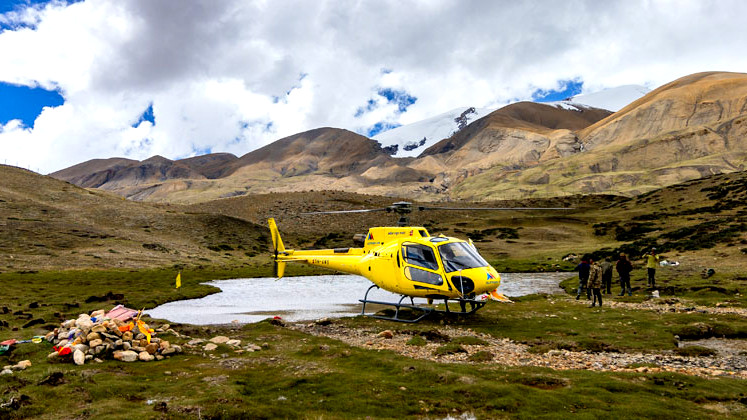
Day 1: Arrival in Kathmandu (1,400m/4,593ft)
Upon your arrival at Tribhuvan International Airport in Kathmandu, you will be greeted by our team and transferred to your hotel. You can spend the day exploring the vibrant streets of Thamel, a popular tourist hub in Kathmandu, and soak in the rich cultural atmosphere of Nepal's capital city.
Day 2: Fly to Lukla (2,800m/9,186ft) and Trek to Phakding (2,610m/8,563ft)
Early in the morning, you'll take a thrilling flight to Lukla, a gateway to the Everest region. The short flight offers spectacular aerial views of the Himalayas. After landing in Lukla, you'll meet the rest of the trekking crew and start your trek to Phakding. The trail follows the Dudh Koshi River, passing through lush forests, small villages, and suspension bridges.
Day 3: Trek to Namche Bazaar (3,440m/11,286ft)
Today's trek takes you along the Dudh Koshi River and involves some uphill climbs. After crossing several suspension bridges, you'll enter Sagarmatha National Park, a UNESCO World Heritage Site. As you ascend further, you'll be rewarded with the first glimpses of Everest and other surrounding peaks. Namche Bazaar, the bustling Sherpa town, is a significant acclimatization point and an excellent place to immerse yourself in the local culture.
Day 4: Acclimatization Day in Namche Bazaar
Acclimatization is crucial to prevent altitude-related issues. Today, you'll spend the day exploring Namche Bazaar and its surroundings. You can hike to Everest View Hotel for stunning panoramic views of Everest, Ama Dablam, and other peaks. Alternatively, you can visit the Sherpa Culture Museum or hike to Khumjung village to see the famous Yeti Skull and experience the Sherpa way of life.
Day 5: Trek to Tengboche (3,870m/12,697ft)
The trail from Namche to Tengboche offers breathtaking views of Everest and its neighboring peaks. You'll trek through rhododendron forests and may encounter wildlife like musk deer and pheasants. Upon reaching Tengboche, you'll visit the renowned Tengboche Monastery, one of the most significant monasteries in the region, offering serene surroundings and a spiritual ambiance.
Day 6: Trek to Dingboche (4,360m/14,304ft)
The trek to Dingboche takes you through lush forests and opens up to panoramic views of Ama Dablam and other peaks. The terrain becomes more barren as you ascend higher, showcasing the rugged beauty of the Himalayas. Dingboche is a beautiful village surrounded by stone walls, providing protection from strong winds.
Day 7: Acclimatization Day in Dingboche
Another acclimatization day is essential before ascending further. You can hike to Nangkartshang Peak or Chhukung Ri for breathtaking views of Island Peak, Makalu, and other mountains. This day will help you adjust to the high altitude and enhance your overall trekking experience.
Day 8: Trek to Lobuche (4,940m/16,210ft)
The trail to Lobuche passes through the Khumbu Glacier, and the landscape becomes more rugged and icy. As you ascend higher, the oxygen levels decrease, making the trek more challenging. Lobuche offers spectacular views of Nuptse, Pumori, and other Himalayan giants.
Day 9: Trek to Gorak Shep (5,164m/16,942ft), Visit Everest Base Camp (5,364m/17,598ft)
Today is a highly anticipated day as you trek to Gorak Shep and then continue to Everest Base Camp. The trail takes you alongside the Khumbu Glacier, and you'll be surrounded by stunning ice formations and mountains. After reaching Everest Base Camp, you'll experience the thrill of standing at the foot of the world's highest peak.
Day 10: Hike to Kala Patthar (5,545m/18,192ft), Descend to Gorak Shep, Helicopter to Kathmandu
Early in the morning, you'll hike to Kala Patthar, a renowned viewpoint for the best sunrise views over Everest, Lhotse, and other peaks. After descending to Gorak Shep, you'll take a scenic helicopter flight back to Kathmandu, offering bird's-eye views of the Himalayas and concluding your trek in style.
Day 11: Departure or Extend Stay in Kathmandu
Today is your departure day. Our team will assist you with airport transfers and bid you farewell. If you choose to extend your stay in Kathmandu, we can help arrange additional activities or side trips to explore more of Nepal's beauty and culture. The Everest Base Camp Trek will undoubtedly leave you with cherished memories and a sense of accomplishment that will last a lifetime.
Note: These are just a few examples of different Everest Base Camp Trek itineraries. You can adjust the duration, acclimatization days, and side trips based on your fitness level, interests, and time available. Keep in mind that longer itineraries provide better acclimatization and a more relaxed pace, while shorter ones are suitable for those with limited time but still want to experience the beauty of the Everest region.
Luxury Everest Base Camp Trek and Acclimatization
The Luxury Everest Base Camp Trek adds a layer of comfort and convenience to your epic journey in the high Himalayas. As you enjoy the stunning landscapes and immerse yourself in the local Sherpa culture, you will also have the opportunity to rest and recuperate in upscale, comfortable accommodations. This luxury touch will undoubtedly help in acclimatizing at such high altitudes.
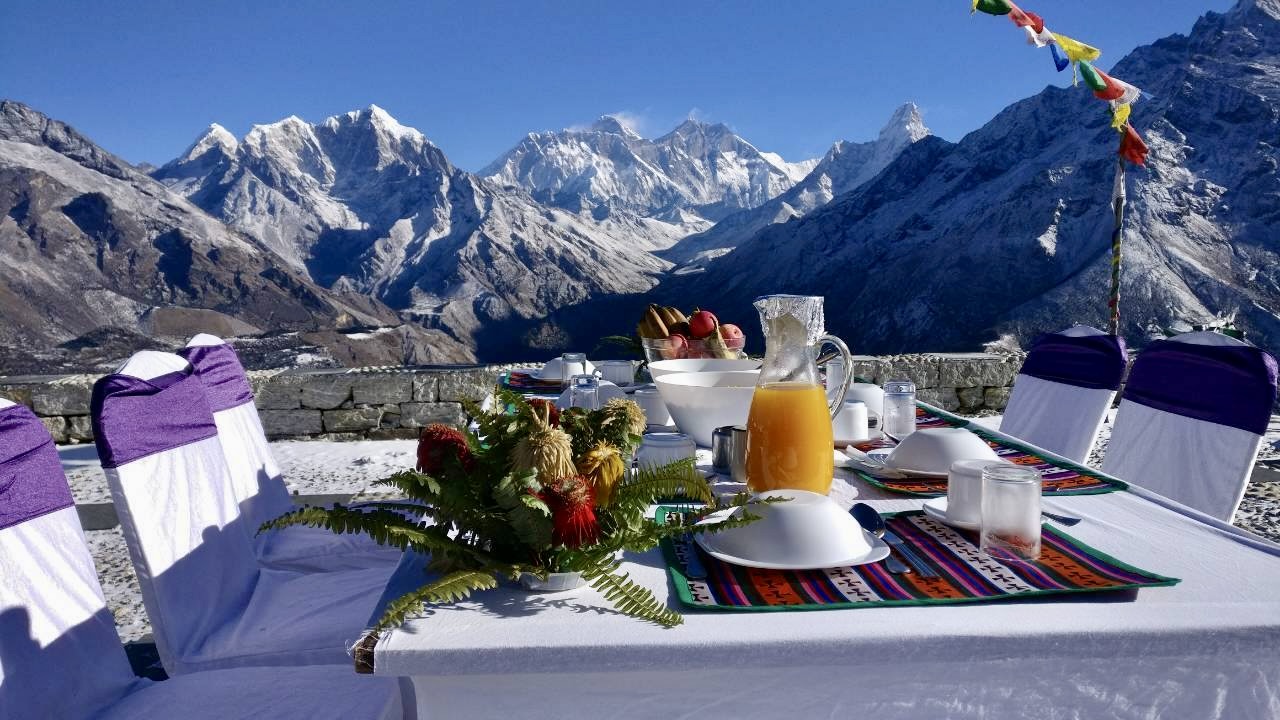
The acclimatization process remains paramount, irrespective of the trek variant you choose. The Luxury Everest Base Camp Trek, it is carefully integrated into the itinerary to allow your body enough time to adapt to the changing altitude. The journey typically includes acclimatization days in Namche Bazaar and Dingboche, which are key locations to help your body get used to the altitude, while also offering incredible views and opportunities to explore the vibrant local culture.
The luxury accommodation options during these rest days provide ample opportunity to relax and rejuvenate. These lodges offer comfortable rooms with attached bathrooms, warm dining areas, and even Wi-Fi in some cases. Additionally, these establishments often provide hearty and nutritious meals, crucial for maintaining your energy levels and assisting in acclimatization.
Choosing a luxury trek doesn't mean compromising on acclimatization or safety. Luxury Holidays Nepal Pvt Ltd is known for carefully crafting our itineraries with an emphasis on slow, steady ascents, allowing ample time for acclimatization. The company’s attention to detail, dedication to the safety and comfort of their clients, and understanding of the local terrain and conditions make them an ideal choice for your luxury Everest Base Camp Trek.
By choosing a Luxury Everest Base Camp Trek, you can ensure a memorable, comfortable, and safe trekking experience that doesn't compromise on the incredible adventure that awaits you in the Everest region. Luxury and safety can go hand in hand on your journey to the base of the world's highest peak.
Difficulty and Preparation of Everest Base Camp Trek
The Everest Base Camp (EBC) Trek is considered a moderately difficult trek, suitable for trekkers with a good level of fitness and previous hiking experience. While it is not a technical climb, it does require endurance, strength, and the ability to hike at higher altitudes.
Difficulty Factors
- High Altitude: The trek takes you to altitudes above 5,000 meters (16,400 feet), where oxygen levels are lower, and altitude-related challenges may arise. Acclimatization days are crucial to allow your body to adjust to the thin air and reduce the risk of altitude sickness.
- Long and Steep Trekking Days: The trek involves daily hiking of around 6-8 hours on challenging mountainous terrain. Some sections have steep ascents and descents, requiring good physical stamina.
- Weather and Temperature: The weather in the Himalayas can be unpredictable, with conditions varying from hot and sunny to cold and snowy. Trekkers must be prepared for changing weather conditions.
- Basic Accommodations: Accommodations along the trail are in teahouses, offering basic facilities like shared rooms and common toilets. Comfort may be limited compared to city accommodations.
Preparation
- Physical Fitness: Prior physical fitness preparation is essential. Cardiovascular exercises like hiking, running, or cycling can help improve your endurance. Strength training can build muscle and reduce the risk of injuries.
- Hiking Practice: Familiarize yourself with trekking gear and practice hiking with a backpack to get used to carrying a load during the trek.
- Altitude Training: If possible, consider doing altitude training or trekking at higher elevations to acclimatize your body to lower oxygen levels.
- Medical Check-up: Consult with a healthcare professional before the trek to ensure you are in good health and discuss any pre-existing medical conditions that may affect your trek.
- Packing: Pack appropriate clothing and gear for both cold and warm weather. Essential items include sturdy hiking boots, warm clothing layers, a good sleeping bag, and trekking poles.
- Mental Preparation: Be mentally prepared for the challenges of the trek. The journey may be physically demanding, but maintaining a positive attitude and determination will help you overcome obstacles.
- Hiring a Guide and Porter: Consider hiring a local guide and porter for added safety, and local knowledge, and to ease the burden of carrying heavy backpacks.
- Permits and Insurance: Obtain the necessary trekking permits and ensure you have travel insurance that covers high-altitude trekking.
With proper preparation, physical fitness, and a positive mindset, the Everest Base Camp Trek can be an immensely rewarding and unforgettable adventure, providing trekkers with a chance to experience the majestic beauty of the Himalayas and the rich Sherpa culture.
Maximize Your Acclimatization
While the itinerary helps in acclimatization, there are additional steps you can take to maximize your body's adjustment to the altitude.
- Hydrate: Drink at least 3-4 liters of water daily. Dehydration can cause or worsen the symptoms of altitude sickness.
- Avoid Alcohol and Caffeine: Both can lead to dehydration and interrupt your sleep, which is essential for acclimatization.
- Eat a High-Calorie Diet: Your body works harder at high altitudes and requires more energy. Make sure you're getting enough carbohydrates.
- Ascend Slowly: This is critical to allow your body time to adapt to the decreasing oxygen levels. Follow the golden rule of not ascending more than 500 meters (1,640 feet) a day.
- 'Climb High, Sleep Low': Try to hike to a higher altitude during the day and sleep at a lower altitude at night. This strategy helps your body acclimate to higher elevations gradually.
- Medication: Medicines like Diamox can help prevent altitude sickness. However, they should be used under a doctor's supervision.
- Rest: If you feel that your body is not coping well with the altitude, take a rest day or two. Listen to your body and don't push yourself too hard.
- Descend if Necessary: If you are experiencing severe symptoms of altitude sickness, the best remedy is to descend immediately.
Remember, acclimatization is key to a successful and enjoyable trek to Everest Base Camp. Taking these steps will help ensure you can adjust to the altitude and maximize your chances of reaching the base camp successfully.
Consider Your Health and Fitness
When planning your acclimatization itinerary for your Everest Base Camp Trek, it's important to take into account your own personal health and fitness level. Everyone's body reacts differently to high altitudes, and your physical condition can play a significant role in how well you acclimate.
If you're in good physical shape and have experience with high-altitude hiking, you may find that you can acclimate more quickly. Regular exercise, especially cardio, helps increase your lung capacity and overall stamina which can be beneficial when acclimating to high altitudes.
Conversely, if you have certain health conditions (like respiratory issues, cardiovascular diseases, or high blood pressure) or if you're less physically active, it might take you longer to acclimate. It's important to discuss your plans with a healthcare professional before you embark on your trek. They can provide advice tailored specifically to you and may suggest additional measures to help you acclimate safely.
Remember that there's no rush to reach the base camp. It's more important to listen to your body, take it slow, and give your body the time it needs to adjust to the changing altitude. Overexerting yourself or pushing your body beyond its limits can increase your risk of altitude sickness and other health complications.
Regardless of your health and fitness level, it's essential to prepare adequately for the trek. That means regular exercise in the months leading up to your trip to build up your endurance, strength, and cardiovascular fitness. Taking the time to physically prepare yourself can make the trek more enjoyable and help your body acclimate to the high altitude more effectively.
Best time to undertake the Everest Base Camp Trek
The best time to undertake the Everest Base Camp Trek is during the pre-monsoon (spring) and post-monsoon (autumn) seasons. These periods offer the most favorable weather and conditions for trekking in the Everest region. Here is more detailed information about the four seasons in Nepal:
Spring Season (March to May)
The spring season is one of the most sought-after times to undertake the Everest Base Camp Trek. With stable weather and longer daylight hours, trekkers can enjoy pleasant conditions for hiking. The skies are usually clear, providing breathtaking views of the surrounding mountains, including the majestic Mount Everest. The rhododendron forests come alive with vibrant colors, enhancing the already picturesque landscape. The temperatures at lower altitudes are moderate, making it comfortable for trekking during the day. This season also attracts many trekkers, creating a vibrant and social atmosphere along the trail.
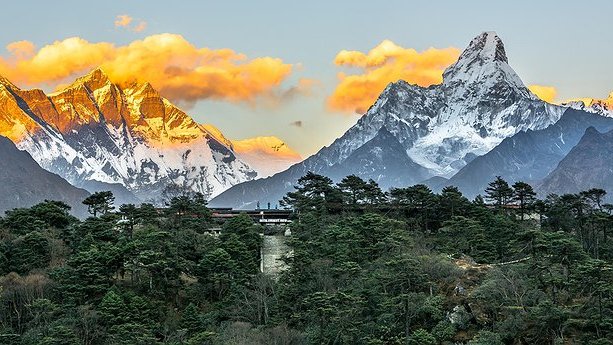
Monsoon/Summer Season (June to August)
The monsoon/summer seasons in Nepal typically coincide, creating a period of hot summer days and heavy rainfall. The unpredictable weather during this time makes it challenging and unsafe for trekking to Everest Base Camp. Continuous rain leads to muddy and slippery trails, increasing the risk of landslides and avalanches, and cloud cover obstructs mountain views, depriving trekkers of the stunning vistas they seek. Due to these unfavorable conditions, it is generally not recommended to undertake the Everest Base Camp Trek during the monsoon and summer seasons. Instead, trekkers are advised to choose the more favorable seasons of spring and autumn for a safer and more enjoyable experience.
Autumn Season (September to November)
The autumn season is another highly recommended time for the Everest Base Camp Trek. After the monsoon rains, the trails are clear and dry, making for excellent trekking conditions. The weather remains stable, with clear skies and uninterrupted mountain views. The temperatures are mild during the daytime, while the nights can be colder, especially at higher altitudes. Autumn is considered the peak trekking season in the Everest region, so trekkers should expect more crowded trails and busy teahouses. It is advisable to book accommodations in advance to secure a comfortable stay along the route. Despite the higher number of trekkers, the stunning vistas and overall trekking experience make it a preferred time for many adventurers.
Winter Season (December to February)
The winter season is not the ideal time for most trekkers to attempt the Everest Base Camp Trek due to extreme cold and snow. The higher altitudes experience freezing temperatures, making the trek more challenging and potentially risky. The trails may be covered with snow and ice, making them slippery and difficult to navigate. Accommodations and facilities along the route may be limited due to the harsh conditions. However, for experienced trekkers who are well-prepared for extreme weather and seeking a quieter and more adventurous experience, the winter months can offer a unique and tranquil journey.
The Everest Base Camp trek is a truly rewarding and life-changing adventure, suitable for trekkers of diverse backgrounds and ages. It allows one to deeply connect with the rich Himalayan culture, experience breathtaking landscapes, and stand in awe at the base of the world's highest mountain. While it presents challenges, being physically fit, mentally prepared, and well-equipped with appropriate trekking gear are vital for a successful journey. Taking time for acclimatization and having a positive mindset will enhance the overall experience. Hiring a local guide and porter not only ensures safety but also provides valuable insights into the local culture and environment. The Everest Base Camp trek is a bucket-list adventure that leaves trekkers with unforgettable memories and a profound appreciation for the natural wonders of the Himalayas.
FAQs: Pick the Best Acclimatization Itinerary for Your Everest Base Camp Trek
Q: What is acclimatization?
A: Acclimatization is the process of your body adjusting to the decreased availability of oxygen at high altitudes. It involves physiological changes in the body, such as increased breathing and heart rate.
Q: Why is acclimatization important for the Everest Base Camp Trek?
A: Acclimatization is crucial to prevent Acute Mountain Sickness (AMS), a potentially life-threatening condition that can occur at high altitudes due to a lack of oxygen.
Q: How does the acclimatization process work?
A: The body acclimatizes by producing more red blood cells to carry oxygen, and by increasing the breathing and heart rate. This process can take a few days to a few weeks.
Q: How can I acclimatize properly on the Everest Base Camp Trek?
A: The best way to acclimatize is by following the "climb high, sleep low" rule, where you ascend to a higher altitude during the day, and then descend to sleep. You should also take rest days during your trek to allow your body to adjust.
Q: How many rest days should I take for acclimatization during the Everest Base Camp Trek?
A: A standard acclimatization itinerary usually includes two rest days during the trek. However, the number of rest days can vary depending on the trekker's physical condition and how well they're adapting to the altitude.
Q: What should I do if I start feeling symptoms of altitude sickness?
A: If you start experiencing symptoms like headache, dizziness, nausea, or fatigue, it's essential to descend immediately and seek medical attention. Remember, the only definitive cure for altitude sickness is to descend.
Q: Can medication help with acclimatization?
A: Medications like Diamox can help to reduce the symptoms of altitude sickness. However, it's not a substitute for proper acclimatization and should be taken only under the supervision of a healthcare professional.
Here are the other options for Everest Region Trekking
Everest Heli Trek with Kalapathher Landing
Gokyo Lakes and Everest Base Camp Trek
Everest Base Camp Heli Trek - 9 Days
VVIP Everest Base Camp Luxury Trek
Everest Base Camp and Gokyo Lakes Luxury Helicopter Trek
Luxury Everest Base Camp Trek - 14 Days
If you need any further information, please contact us by email: at [email protected], Phone: at +977- 985 100 5129 (WhatsApp)
#Tags
Tripadvisor
5.0910 reviewsGoogle
4.8110 reviewsFacebook
4.1 recommend44 ReviewsTrustpilot
4.1 Great(5 reviews)- Trusted by50K plus traveller

